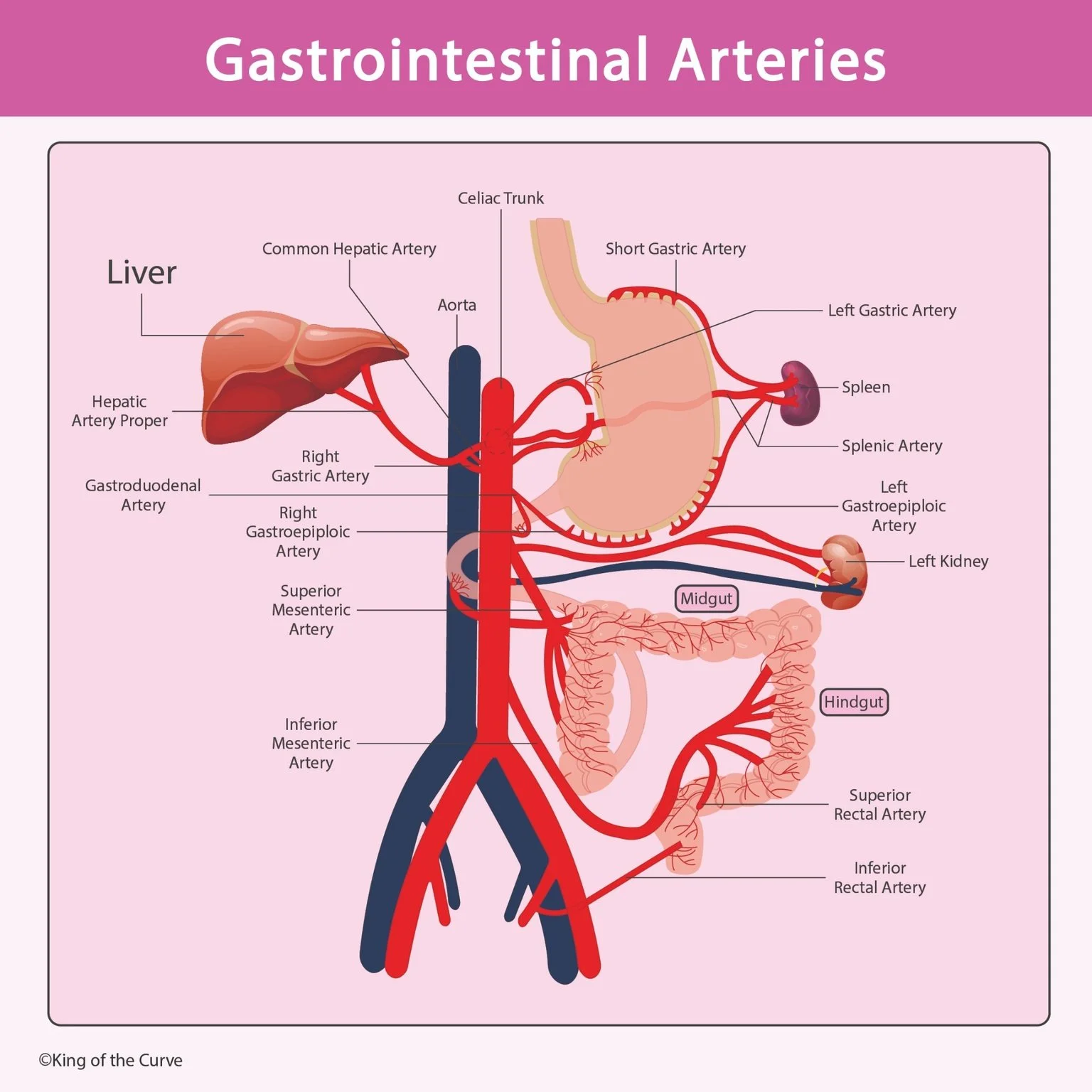🩸 Gastrointestinal Arteries: High-Yield Anatomy for the MCAT & NCLEX
The blood supply to the GI tract is one of those anatomy details that students often cram and forget—yet it shows up repeatedly on the MCAT and NCLEX. On the MCAT, it’s often hidden in passage-based biology/biochemistry questions. On the NCLEX, it ties into clinical nursing care for abdominal trauma, ischemia, or surgery.
🔍 Major Blood Supply Overview
| Artery | Region Supplied | Key Structures | MCAT/NCLEX Angle |
|---|---|---|---|
| Celiac Trunk | Foregut | Stomach, liver, spleen, pancreas, proximal duodenum | Foregut ischemia; ulcer bleeds (e.g., left gastric); splenic injury |
| Superior Mesenteric Artery (SMA) | Midgut | Distal duodenum → proximal 2/3 transverse colon | SMA syndrome; embolic bowel ischemia; post-prandial pain |
| Inferior Mesenteric Artery (IMA) | Hindgut | Distal 1/3 transverse colon → rectum | Ischemic colitis; lower GI bleed patterns |
| Collateral / Watershed | SMA–IMA border zones | Splenic flexure, rectosigmoid junction | Most vulnerable during hypoperfusion/shock → ischemia risk |
🧠 MCAT high-yield points
Embryology: Foregut (celiac), midgut (SMA), hindgut (IMA). Know the cutoffs.
Pathology tie-ins:
SMA syndrome (duodenum compressed between SMA and aorta).
Ischemic colitis at watershed areas.
Upper vs. lower GI bleeds → which artery is likely involved?
Buzzwords in passages: “abdominal pain after eating,” “mesenteric ischemia,” “splenic flexure.”
👉 Test tip: If you see “watershed area” or “hypoperfusion,” think SMA–IMA border zones.
💉 NCLEX/Clinical angle
GI bleeds: Nursing care includes recognizing hematemesis (foregut bleed) vs. melena/hematochezia (midgut/hindgut bleed).
Mesenteric ischemia: Severe pain out of proportion to exam findings; urgent intervention required.
Post-op care: Vascular compromise to gut can occur after abdominal surgery; nurses monitor for bowel ischemia.
🧪 Quick Practice Qs
Which artery supplies the proximal duodenum?
→ Celiac trunk (foregut).A clot in the SMA will most affect which region?
→ Small intestine and proximal 2/3 of transverse colon.Pain at the splenic flexure in a patient with hypotension is most likely due to?
→ Ischemia in a watershed zone between SMA and IMA.
🚀 Study Smarter with KOTC
Don’t just memorize arteries—see them, quiz them, and master them.
Warm up daily with the Question of the Day
Explore 1,000+ diagrams at Study Science
Get free access at Free Lifetime
Starting out? Check Pre-Med Essentials
Frequently Asked Questions (FAQs)
-
Aim for 4-6 focused hours, ensuring you incorporate breaks to avoid burnout.
-
Practice mindfulness techniques, take practice exams under realistic conditions, and maintain a balanced lifestyle.
-
Set short-term goals, seek support from mentors, and reward yourself for small achievements.
-
Regular exercise improves focus, reduces stress, and enhances overall mental clarity.
-
KOTC offers personalized learning tools, gamification features, and adaptive question banks to help students stay on track without burnout.


